The War of Two Worlds. BRICS
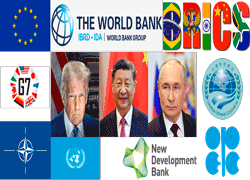 Do not lose sight of the big game: The hegemon is fighting for supremacy against a multipolar but heterogeneous world. Part 2 is about the organization that is challenging the Collective West economically: BRICS.
Do not lose sight of the big game: The hegemon is fighting for supremacy against a multipolar but heterogeneous world. Part 2 is about the organization that is challenging the Collective West economically: BRICS.
Introduction
In Part 1 of this three-part series, we looked at the history of the great conflicts of the 20th century and the (character) traits and state of the Collective West. In this 2nd part, we describe the organization that we are mainly concerned with when we talk about the economic challenges facing the Collective West: BRICS.
This blog sets priorities in the selection of its topics and one focus has always been BRICS. We consider this topic to be so important that we dedicated the very first article of this blog to BRICS on November 18, 2022: “The unstoppable rise of the East” and subsequently covered and highlighted BRICS in many other articles and did not miss the opportunity to attend last year’s BRICS summit in Kazan.
Media in the West had a completely different focus and completely missed one of the biggest geo-economic developments, which we characterize as a tectonic shift. If BRICS was mentioned at all, it was with a condescension and hubris that is hard to describe. In the third part of this series, one chapter will be entitled “Hubris meets Nemesis”. This attitude of the West, not only with regard to economic but also military issues, has already reduced the EU to a geopolitical marginal figure and the consolidation of power that Trump is advancing in his area of influence (Mexico, Canada, Panama, the Middle East and Greenland) suggests that loud-mouthed Western Europe will be taken at its word and left to its own fate.
The level of education regarding BRICS as an organization in the West is, for want of another adjective, pitoyable. A few days ago, the Americans once again won the Oscar for “”freedom from education“” when none other than President Trump himself, with almost refreshing ignorance, saw Spain as a BRICS member.
'You'll figure it out': Donald Trump says Spain is a Brics group member
In Part 3, we will return several times to the consequences of “freedom from education” and highlight the emerging difficulties associated with this major issue.
In the following overview, we mainly show maps, figures and diagrams, which are self-explanatory.
BRICS – the captain of the Global South
Accelerated development due to the behavior of the US
In our numerous articleson BRICS, we have shown that the accelerated rise of BRICS can ultimately be seen as a consequence of the US’s aggressive foreign policy. A policy which, in addition to military aggression, was characterized by the US allowing its reserve currency, the US dollar, to fall into disrepair and using it as a weapon, which culminated in 2022 in the West freezing the currency reserves of the Russian central bank and now stealing them – at least the proceeds from them.
Alongside the SCO and other organizations in the Global South, BRICS is definitely the most important organization that has ever existed in economic terms. The numbers resulting from the current full members and partner states are already very impressive and clearly outstrip the G7 as the main organization of the Collective West.
In addition to the members and partners already admitted, the large list of countries that want to join BRICS shows that a community is developing here that has the potential to dominate the world economically. It therefore makes sense to briefly examine the weight of the most important representative of the Global South with the help of a few maps and lists.
Members
BRICS consisted of Brazil, Russia, India and China from 2009, South Africa joined in 2011 and Iran, the United Arab Emirates, Egypt and Ethiopia were added in January 2024; Indonesia joined in January 2025 and had partner status from October 2024 (Kazan).
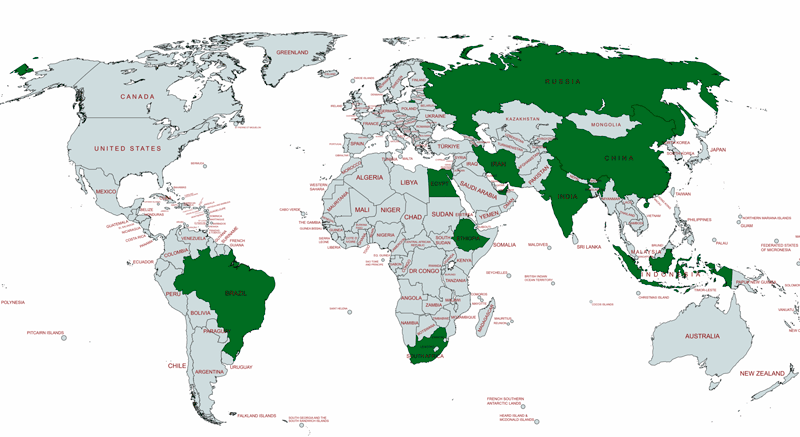
We show gross national product adjusted for purchasing power. Using the U.S. dollar as a measure of GDP distorts a country’s economic power: if you want to realistically measure financial strength, it makes a big difference whether a Big Mac costs twice as much in one place in U.S. dollars as it does in another. The so-called Big Mac Index is reason enough to use purchasing power adjusted figures when comparing GDP figures. The reason the Western media use the unadjusted figures is pure marketing to hide the devaluation of the US dollar and make it appear stronger than it is.
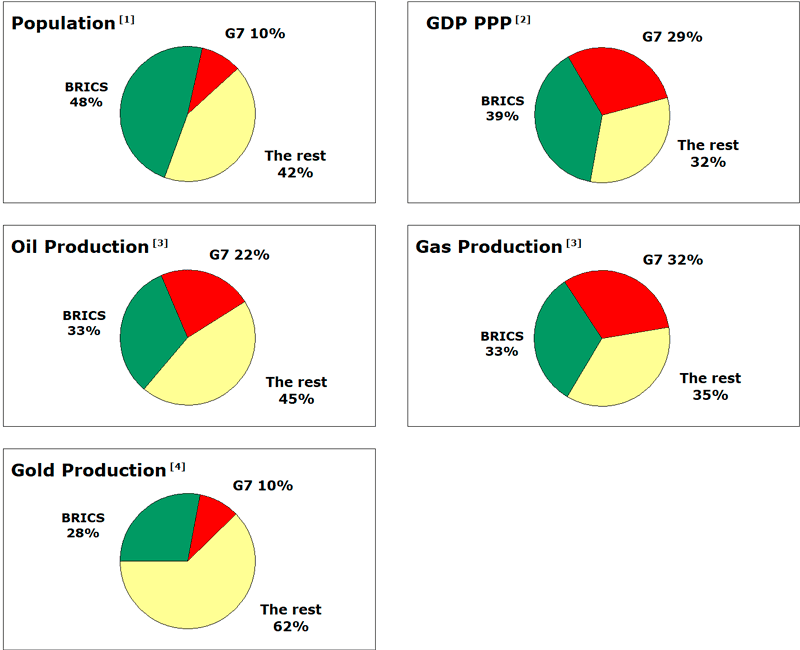
Classification of the numbers
Oil Production
The following additional facts should be considered when evaluating oil production figures:
First, while the U.S. is still the world’s largest oil producer, accounting for about 18% of global production, it is also the world’s largest consumer, consuming more than 20% of the world’s oil. This means that the U.S. is currently unable to even cover its own consumption. This fact alone is a compelling reason for the US to put pressure on Saudi Arabia, for example, to prevent it from joining BRICS.
Second, the major oil-producing members of BRICS have a great deal of influence or even control over OPEC. Since BRICS thus also controls OPEC and thus controls the price and distribution of a large part of oil, BRICS can be said to have an (indirect) monopoly position.
Third, the production cost of US oil is several times higher than the production cost in the BRICS countries.
Therefore, these factors further strengthen the BRICS’ power position with regard to oil.
Natural gas
With regard to natural gas, it should be noted that with Iran’s accession to BRICS, the two largest natural gas producers in the world are joint members of BRICS: Russia and Iran.
The largest non-BRICS gas producer is Qatar, which is (still) allied with the United States. BRICS is therefore also a real power center when it comes to natural gas.
Gold
Regarding gold, it is worth noting that China and Russia are the world’s #1 and #2 gold producers, respectively. I mention gold here because there is a good chance that gold will once again play an important role in future monetary systems – we will discuss this in the next article.
Further figures
According to statements by President Putin on October 18, 2024, which we discussed in our article “Four days until the opening of BRICS – two appointments of the Russian President in one day”, further figures on BRICS are important:
- BRICS accounts for 39% of the world’s industrial production, compared to just 31% for the G7.
- BRICS produces 44 percent of the world’s wheat, the G7 only 19 percent.
- The figures for rice are as follows: BRICS 54 percent, G7 2.4 percent.
- The figures for the production of important raw materials are as follows: BRICS produces 74 percent of aluminum, the G7 five percent. The figures for palladium are 77 to 7 in favor of BRICS.
Partners
Official partner states, i.e. in the antechamber for full membership, are currently Belarus, Bolivia, Kazakhstan, Thailand, Cuba, Uganda, Malaysia and Uzbekistan.
Turkey, which put a lot of energy into becoming a full member last year, did not even manage to become a partner in Kazan. Many media assumed that Turkey would become a partner. The BRICS leadership had given the green light for 13 countries to become partners without mentioning their names, as the extent of their readiness for full membership or other BRICS status had to be discussed with them.
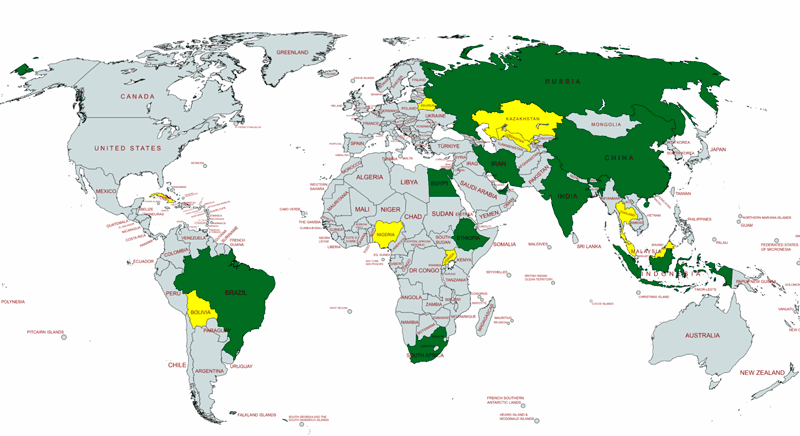
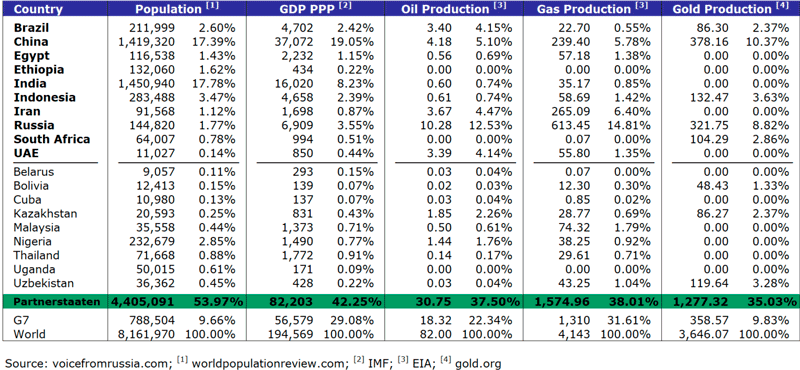
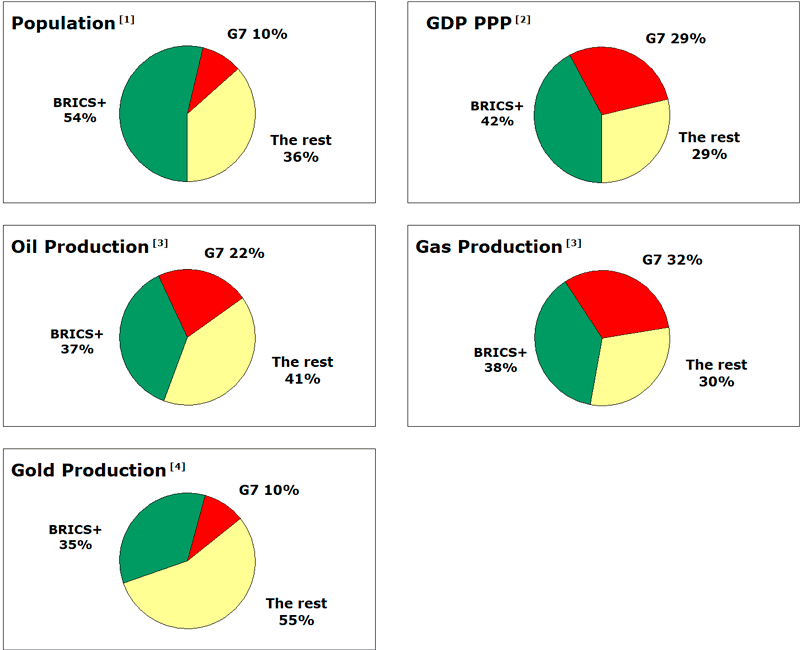
Turkey and Saudi Arabia
In October, we pointed out that lists circulating on the internet, on which Turkey also appeared as a partner, should be treated with caution. We were already skeptical after the statements made by Russian presidential advisor Anton Kobyakov in Kazan on 23 October 2024 – and we were right. President Erdogan’s disloyal and pitoyable role in Syria, which was nothing less than a betrayal of Iran, Russia, Syria and also BRICS, will probably make a partnership or even membership of Turkey under Erdogan impossible in the medium to long term; we wrote about this in “The empire strikes back”.
Saudi Arabia was already invited as a full member in the summer of 2023, but has not yet ratified its accession. Saudi Arabia is one of the world’s largest producers of oil, accounting for almost 13% of global production, and is therefore of great interest to BRICS, but also to the Collective West.
Saudi Arabia, or rather the ruling Saud family, has been an ally of the US since the end of the Second World War, and this relationship has been further strengthened since the “Petrodollar” agreement in 1974. During the Biden administration, the relationship with the US suffered massively, while at the same time cooperation with China and Russia solidified to an unprecedented level.
The problem that Saudi Arabia now has is the gigantic investments that the state and private individuals have made, particularly in the US and the UK. Government investments in the US alone amount to over USD 35 billion and investments in the UK are said to be around USD 75 billion. Due to the geopolitical situation in the world and the West’s aggressive sanctions policy, Saudi concerns that these investments could be confiscated in the event of a BRICS accession are definitely justified. Saudi Arabia is important for BRICS. China has replaced the US as Saudi Arabia’s largest trading partner.
Faisal F. Alibrahim, the Minister of Economy and Planning of Saudi Arabia, said at the World Governments Summit on February 12, 2025 that the Kingdom was going through a “rigorous process” to assess the pros and cons of joining the bloc.
“Like any multilateral platform, we carefully assess the benefits and challenges”
Faisal F. Alibrahim, 12. Februar 2025
It should also be noted that although Mohammed bin Salman (MbS) is currently the designated heir to the throne after King Salman, there are traditionally several potential candidates within the Saudi royal family. MbS was officially named crown prince by King Salman in 2017, replacing his cousin Mohammed bin Nayef, who was previously earmarked as heir to the throne. But according to Saudi experts, his definitive ascension to the royal throne after the death of King Salman depends on him getting on well with the Saudi lobby in Washington. Only after his accession to the throne will we know how much leeway he will have with regard to cooperation with BRICS.
Saudi Arabia will be a typical example of a plaything of the two worlds, on the one hand because of its geographical location and on the other because of its gigantic oil reserves. We will come back to this in Part 3.
Interested countries
The list of countries that are interested in joining or have submitted membership applications is incredible and describes the potential of BRICS in the future.
Eight countries (Azerbaijan, Bangladesh, Myanmar, Pakistan, Senegal, Sri Lanka, Syria, Venezuela) have submitted formal membership applications. A further 33 countries have expressed an interest in joining, although this figure is not set in stone.
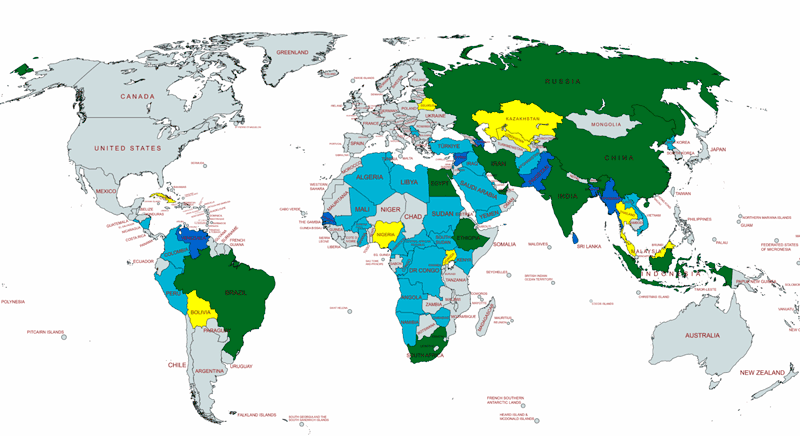
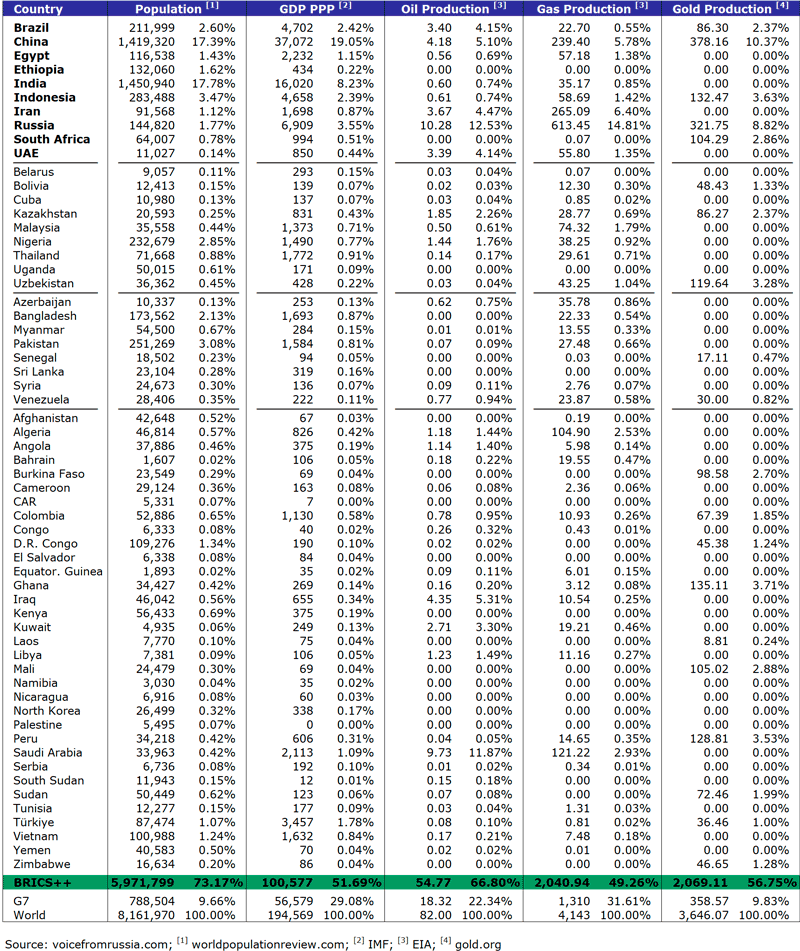
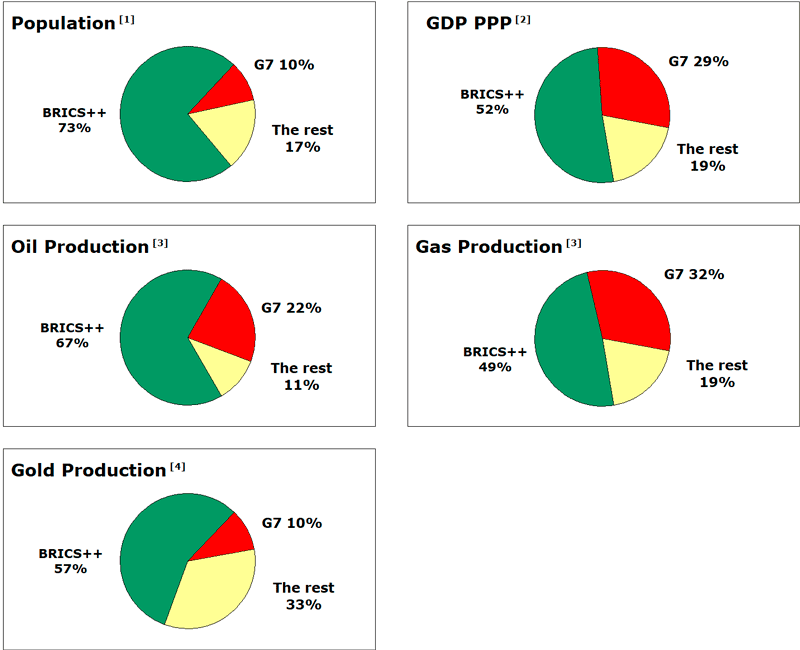
Overwhelming
Facts speak for themselves. The economic superiority of BRICS over the Collective West is already impressive and the list of interested parties is overwhelming.
The general public in the West is completely unaware of this, because the Western media is pursuing a veritable ostrich policy: all countries in the Global South are looked down upon and disparagingly referred to as third world countries or emerging economies in order to make the public believe that these people live in poverty and misery.
Last summer, I traveled by train in both China and Germany. In China, I traveled in complete luxury at 350 km/h between the most modern train stations to the minute. In Germany, I traveled on a train (ICE) pretending to be modern, between run-down stations with huge delays and the wishful thinking that these trains would run at 200 km/h if they could. However, this was not possible due to the countless construction sites and the equally numerous lines that are not yet equipped for these speeds.
To put it ironically, perhaps the media in the West thought that the Third World was the modern world and the Western world was the one that was increasingly falling behind.
The development around BRICS shows that the world has reached a point where the overwhelming economic power of this organization and its members can no longer be concealed. The West will probably soon form a new narrative and create a myth of the danger posed by BRICS. Although BRICS stands for a multipolar world and free trade between all – i.e. also credibly propagated between the big and the small – we will very soon be served with a threatening image. The two leading members of BRICS – China and Russia – are already being referred to as the new axis of evil.
President Trump has already realized what BRICS means for the Petrodollar and thus for the US. He is trying to use the carrot and stick by trying to make it palatable for Russia to return to the G7 (G8) on the one hand and threatening BRICS on the other. He is not doing this because he likes Putin or Russia, these attempts are purely opportunistic. However, I don’t think Russia will see the G7 as an attractive carrot, because the members – apart from the US – are not energetic countries that are interesting for Russia. Germany, which will always be important for Russia, can also be brought back in bilaterally at a later date.
We have often pointed out that Russia seeks long-term agreements and keeps to them – in stark contrast to the US and the entire Collective West. I refer you to my article “Loyalty – the mortar of life and geopolitics”. I categorically rule out Russia turning against BRICS. The BRICS states were loyal to Russia during the sanctions storm. The Russians have a long memory.
We described the initial situation in the first and this second part of the series. The bare numbers indicate that the Collective West is doing poorly in an economic competition against the Global South, much like the British could not have competed against the Germans for a long time before the First World War.
In the upcoming 3rd part of this series, we let the big game begin and show a possible course of this war of the worlds.
Peter Hanseler
Continuation




